Subduction–Accretion History of the Paleo-Pacific Plate Beneath the Eurasian Continent: Evidence from the Tongjiang Accretionary Complex, NE China
Abstract
1. Introduction
2. Regional Setting
3. Sampling and Petrography
4. Analytical Methods
4.1. Zircon U–Pb Dating
4.2. Zircon Hf Isotopes
5. Results
5.1. Zircon U–Pb Dating
5.2. Zircon Hf Isotopes
6. Discussion
6.1. Depositional Age of the Matrix of the Tongjiang Accretionary Complex
6.2. Provenance of Detrital Zircons in the Matrix of the Tongjiang Accretionary Complex
6.3. Implications for the Westward Subduction and Accretion Process of the Paleo–Pacific Ocean
7. Conclusions
- The lower limit of the depositional age of the matrix of the fine silty mudstone, phyllonite and mylonitized fine argillaceous siltstone in the Tongjiang accretionary complex may be 261–247 Ma, 175 Ma and 168 Ma, respectively, with a younging trend from west to east. Provenance analysis suggested that the detrital zircons may be mainly derived from blocks in the NAC belt and the Jiamusi and Xingkai blocks;
- Combining the lower limit of the depositional age of the matrix in the Yuejinshan and Raohe accretionary complexes and chronological data of the blocks in the NAC belt, we propose that the NAC may be mainly composed of the Late Permian Triassic, Jurassic and Early Cretaceous accretionary complexes from west to east and is the material record of the subduction–accretion of the Paleo–Pacific Plate;
- Summarizing the rock association of subduction in the NAC belt, we hold the opinion that the initial age of subduction of the Paleo–Pacific Plate may be the Permian. The accretionary complexes in the NAC belt have a younging trend from west to east, indicating a westward subduction and accretion process of the Paleo–Pacific Ocean during the Permian to Early Cretaceous.
Supplementary Materials
Author Contributions
Funding
Data Availability Statement
Acknowledgments
Conflicts of Interest
References
- Matsuda, T.; Isozaki, Y. Well-documented travel history of Mesozoic pelagic chert in Japan. Tectonics 1991, 10, 475–499. [Google Scholar] [CrossRef]
- Cawood, P.A.; Kröner, A.; Collins, W.J.; Kusky, T.M.; Mooney, W.D.; Windley, B.F. Accretionary Orogens Through Earth History. Geol. Soc. Lond. Spec. Publ. 2009, 318, 1–36. [Google Scholar] [CrossRef]
- Kusky, T.M.; Windley, B.F.; Safonova, I.; Wakita, K.; Wakabayashi, J.; Polat, A.; Santosh, M. Recognition of ocean plate stratigraphy in accretionary orogens through Earth history:A record of 3.8 billion years of sea floor spreading, subduction, and accretion. Gondwana Res. 2013, 24, 501–547. [Google Scholar] [CrossRef]
- Safonova, I.Y.; Santosh, M. Accretionary complexes in the Asia-Pacific region: Tracing archives of ocean plate stratigraphy and tracking mantle plumes. Gondwana Res. 2014, 25, 126–158. [Google Scholar] [CrossRef]
- Xiao, W.J.; Li, J.L.; Song, D.F.; Han, C.M.; Wan, B.; Zhang, J.E.; AO, S.J.; Zhang, Z.Y. Structural analyses and spatio-temporal constraints of accretionary orogens. Earth Sci. 2019, 44, 1661–1687. [Google Scholar]
- Zhou, J.B. Accretionary complex: Geological records from oceanic subduction to continental deep subduction. Sci. China Earth Sci. 2020, 50, 1709–1726. [Google Scholar] [CrossRef]
- Yan, Z.; Fu, C.L.; Niu, M.L.; Zhang, J.E.; Xiao, W.J.; Wang, Z.Q. Recognition and significance of accretionary prism in orogenic belts. Chin. J. Geol. 2021, 56, 430–448. [Google Scholar]
- Zhou, J.B.; Wilde, S.A.; Zhang, X.Z.; Zhao, G.C.; Zheng, C.Q.; Wang, Y.J.; Zhang, X.H. The onset of Pacific margin accretion in NE China: Evidence from the Heilongjiang high-pressure metamorphic belt. Tectonophysics 2009, 478, 230–246. [Google Scholar] [CrossRef]
- Zhou, J.B.; Wilde, S.A. The crustal accretion history and tectonic evolution of the NE China segment of the Central Asian Orogenic Belt. Gondwana Res. 2013, 23, 1365–1377. [Google Scholar] [CrossRef]
- Lan, H.Y.; Li, S.Z.; Guo, L.L.; Li, X.Y.; Liu, Y.J.; Liu, B.; Santosh, M.; Cao, X.Z.; Zhang, R.X.; Wang, G.Z. Mesozoic deformation of the Nadanhada Terrane and its implications on the subduction of the Paleo-Pacific Plate. J. Asian Earth Sci. 2022, 232, 105166. [Google Scholar] [CrossRef]
- Li, S.Z.; Zhang, Y.; Guo, L.L.; Suo, Y.H.; Cao, H.H.; Li, X.Y.; Zhou, Z.Z.; Wang, P.C.; Guo, R.H. Mesozoic deformation and accretionary orogenic processes around the Nadanhada Terrane. Earth Sci. Front. 2017, 24, 200–212. [Google Scholar]
- Zhou, J.B.; Pu, X.G.; Hou, H.S.; Han, W.; Cao, J.L.; Li, G.Y. The Mesozoic accretionary complex in NE China and its tectonic implications for the subduction of the Paleo-Pacific plate beneath the Eurasia. Acta Petrol. Sin. 2018, 34, 2845–2856. [Google Scholar]
- Xu, W.L.; Sun, C.Y.; Tang, J.; Luan, J.P.; Wang, F. Basement nature and tectonic evolution of the Xing’an-Mongolian Orogenic Belt. Earth Sci. 2019, 44, 1620–1646. [Google Scholar]
- Han, W.; Zhou, J.B. Paleo-Pacific subduction-accretion: Geochemical and geochronology constraints from the Raohe accretionary complex, NE China. Acta Petrol. Sin. 2020, 36, 703–725. [Google Scholar]
- Xu, W.L.; Wang, Y.N.; Wang, F.; Tang, J.; Long, X.Y.; Dong, Y.; Li, Y.; Zhang, X.Z. Evolution of western Pacific subduction zones: Constraints from accretionary complexes in NE Asian continental margin. Acta Palaeontol. Sin. 2022, 68, 1–17. [Google Scholar]
- Guo, F. Geological records of the Pacific plate subduction in the Northeast Asian continental margin: An overview. Bull. Miner. Petrol Geochem. 2016, 35, 1082–1089. [Google Scholar]
- Wang, Z.H. The Mesozoic-Early Cenozoic Tectono-Magmatic Evolution of the Nadanhada Terrane. Ph.D. Thesis, Jilin University, Changchun, China, 2017. [Google Scholar]
- Wang, Z.H.; Ge, W.C.; Yang, H.; Bi, J.H.; Ji, Z.; Dong, Y.; Xu, W.L. Petrogenesis and tectonic implications of Early Jurassic volcanic rocks of the Raohe accretionary complex, NE China. J. Asian Earth Sci. 2017, 134, 262–280. [Google Scholar] [CrossRef]
- Tang, J.; Xu, W.L.; Wang, F.; Ge, W.C. Subduction history of the Paleo-Pacific slab beneath Eurasian continent: Mesozoic-Paleogene magmatic records in Northeast Asia. Sci. China Earth Sci. 2018, 61, 527–559. [Google Scholar] [CrossRef]
- Zhou, J.B.; Cao, J.L.; Wilde, S.A.; Zhao, G.C.; Zhang, J.J.; Wang, B. Paleo-Pacific subduction-accretion: Evidence from Geochemical and U-Pb zircon dating of the Nadanhada accretionary complex, NE China. Tectonics 2014, 33, 2444–2466. [Google Scholar] [CrossRef]
- Sun, M.D.; Xu, Y.G.; Wilde, S.A.; Chen, H.L.; Yang, S.F. The Permian Dongfanghong island-arc gabbro of the Wandashan Orogen, NE China: Implications for Paleo-Pacific subduction. Tectonophysics 2015, 659, 122–136. [Google Scholar] [CrossRef]
- Yang, H.; Ge, W.C.; Dong, Y.; Bi, J.H.; Wang, Z.H.; Ji, Z. Record of Permian-Early Triassic continental arc magmatism in the western margin of the Jiamusi Block, NE China: Petrogenesis and implications for Paleo-Pacific subduction. Int. J. Earth Sci. 2017, 106, 1919–1942. [Google Scholar] [CrossRef]
- Zhou, J.B.; Shi, A.G.; Jing, Y. The Combined NE China blocks:Tectonic evolution and supercontinent reconstructions. J. Jilin Uni. Earth Sci. Ed. 2016, 46, 1042–1055. [Google Scholar]
- Khanchuk, A.I.; Kemkin, I.V.; Kruk, N.N. The Sikhote-Alin orogenic belt, Russian South East: Terranes and the formation of continental lithosphere based on geological and isotopic data. J. Asian Earth Sci. 2016, 120, 117–138. [Google Scholar] [CrossRef]
- Zhou, J.B.; Li, L. The Mesozoic accretionary complex in Northeast China: Evidence for the accretion history of Paleo-Pacific subduction. J. Asian Earth Sci. 2017, 145, 91–100. [Google Scholar] [CrossRef]
- Zheng, H.; Sun, X.M.; Wan, K.; Wang, P.J.; He, S.; Zhang, X.Q. Structure and tectonic evolution of the Late Jurassic-Early Cretaceous Wandashan accretionary complex, NE China. Int. Geol. Rev. 2019, 61, 17–38. [Google Scholar] [CrossRef]
- Liang, Y.; Zheng, H.; Li, H.; Algeo, J.T.; Sun, X.M. Late Paleozoic–Mesozoic subduction and accretion of the Paleo-Pacific Plate: Insights from ophiolitic rocks in the Wandashan accretionary complex, NE China. Geosci. Front. 2021, 12, 101242. [Google Scholar] [CrossRef]
- Golozubov, V.V.; Khanchuk, A.I. The Heilongjiang Complex as a Fragment of a Jurassic Accretionary Wedge in the Tectonic Windows of the Overlying Plate: A Flat Slab Subduction Model. Russ. J. Pac. Geol. 2021, 40, 3–17. [Google Scholar] [CrossRef]
- Kojima, S. Mesozoic terrane accretion in Northeast China, Sikhote-Alin and Japan regions. Palaeogeogr. Palaeocl. 1989, 69, 213–232. [Google Scholar] [CrossRef]
- Li, W.M.; Liu, Y.J.; Zhao, Y.L.; Feng, Z.Q.; Zhou, J.P.; Wen, Q.B.; Ling, C.Y.; Zhang, D. Tectonic evolution of the Jiamusi Block, NE China. Acta Petrol. Sin. 2020, 36, 665–684. [Google Scholar]
- Wang, Y.N.; Xu, W.L.; Wang, F.; Zhang, X.Z. Late Paleozoic–Mesozoic tectonic evolution of the northeastern Asian continental margin revealed by sedimentary formations and fossil accretionary complexes. Earth-Sci. Rev. 2021, 225, 103908. [Google Scholar] [CrossRef]
- Bi, J.H. Late Paleozoic Tectonic-Magmatic Evolution of the Eastern Jiamusi Massif. Ph.D. Thesis, Jilin University, Changchun, China, 2018. [Google Scholar]
- Zeng, Z.; Zhang, X.Z.; Zhou, J.B.; Zhang, H.T.; Liu, Y.; Cui, W.L. Geochemistry and zircon U-Pb age of Permian metabasalts in the Yuejinshan complexes and its tectonic implications. Geotecton. Metallog. 2018, 42, 365–378. [Google Scholar]
- Liu, Y.J.; Feng, Z.Q.; Jiang, L.W.; Jin, W.; Li, W.M.; Guan, Q.B.; Wen, Q.B.; Liang, C.Y. Ophiolite in the eastern Central Asian Orogenic Belt, NE China. Acta Petrol. Sin. 2019, 35, 3017–3047. [Google Scholar]
- Zhang, D.; Liu, Y.J.; Li, W.M.; Li, S.Z.; Iqbal, M.Z.; Chen, Z.X. Marginal accretion processes of Jiamusi Block in NE China: Evidences from detrital zircon U-Pb age and deformation of the Wandashan Terrane. Gondwana Res. 2020, 78, 92–109. [Google Scholar] [CrossRef]
- Cheng, R.Y.; Wu, F.Y.; Ge, W.C.; Sun, D.Y.; Yang, X.M.; Yang, J.H. Emplacement age of the Raohe Complex in eastern Heilongjiang Province and the tectonic evolution of the eastern part of Northeastern China. Acta Petrol Sin. 2006, 22, 353–376. [Google Scholar]
- Zhang, D. Marginal Accretion Processes of Jiamusi Block in NE China: Evidences from Mesozoic Clastic Rocks of the Wandashan Terrane. Master’s Thesis, Jilin University, Changchun, China, 2019. [Google Scholar]
- Meng, E.; Xu, W.L.; Yang, D.B.; Pei, F.P.; Yu, Y.; Zhang, X.Z. Permian volcanisms in eastern and southeastern margins of the Jiamusi Massif, northeastern China: Zircon U–Pb chronology, geochemistry and its tectonic implications. Chin. Sci. Bull. 2008, 53, 1231–1245. [Google Scholar] [CrossRef]
- Xu, W.L.; Wang, F.; Meng, E.; Gao, F.H.; Pei, F.P.; Yu, J.J.; Tang, J. Paleozoic-Early Mesozoic tectonic evolution in eastern Heilongjiang Province, NE China: Evidence from igneous rock association and U-Pb geochronology of detrital zircons. J. Jilin Uni. Earth Sci. Ed. 2012, 42, 1378–1389. [Google Scholar]
- Li, G.Y.; Zhou, J.B.; Li, L. The Early Permian active continental margin at the eastern margin of the Jiamusi Block, NE China: Evidenced by zircon U–Pb chronology and geochemistry of the Erlongshan andesites. Geol. J. 2019, 55, 1670–1688. [Google Scholar] [CrossRef]
- Li, G.Y.; Zhou, J.B.; Li, L. The Jiamusi Block: A hinge of the tectonic transition from the Paleo-Asian Ocean to the Paleo-Pacific Ocean regimes. Earth Sci. Rev. 2023, 236, 104279. [Google Scholar] [CrossRef]
- Bi, J.H.; Ge, W.C.; Yang, H.; Zhao, G.C.; Xu, W.L.; Wang, Z.H. Geochronology, geochemistry and zircon Hf isotopes of the Dongfanghong gabbroic complex at the eastern margin of the Jiamusi Massif, NE China: Petrogensis and tectonic implications. Lithos 2015, 234–235, 27–46. [Google Scholar] [CrossRef]
- Bi, J.H.; Ge, W.C.; Yang, H.; Wang, Z.H.; Xu, W.L.; Yang, J.H.; Xing, D.H.; Chen, H.J. Geochronology and geochemistry of late Carboniferous–middle Permian I-and A-type granites and gabbro–diorites in the eastern Jiamusi Massif, NE China: Implications for petrogenesis and tectonic setting. Lithos 2016, 266–267, 213–232. [Google Scholar] [CrossRef]
- Bi, J.H.; Ge, W.C.; Yang, H.; Wang, Z.H.; Dong, Y.; Liu, X.W.; Ji, Z. Age, petrogenesis, and tectonic setting of the Permian bimodal volcanic rocks in the eastern Jiamusi Massif, NE China. J. Asian Earth Sci. 2017, 134, 160–175. [Google Scholar] [CrossRef]
- Liu, K.; Zhang, J.J.; Ge, M.H.; Ling, Y.Y. Mesozoic Subduction of the Paleo-Pacific Plate along the eastern Margin of the Xing-Meng Orogenic Belt. Bull. Miner. Petrol Geochem. 2016, 35, 1098–1108. [Google Scholar]
- Zeng, Z. The Tectonic Characteristics and Evolution of Jiamusi Massif and Wandashan Complex. Ph.D. Thesis, Jilin University, Changchun, China, 2017. [Google Scholar]
- Cui, W.L. The Discovery and Significance of Permian Subducting Oceanic Crust on the eastern Margin of Jiamusi Massif, NE China. Master’s Thesis, Jilin University, Changchun, China, 2018. [Google Scholar]
- Wu, F.Y.; Yang, J.H.; Lo, C.H.; Wilde, S.A.; Sun, D.Y.; Jahn, B.M. The Heilongjiang group: A Jurassic accretionary complex in the Jiamusi Massif at the western Pacific margin of northeastern China. Isl. Arc. 2007, 16, 156–172. [Google Scholar] [CrossRef]
- Feng, G.Y.; Dilek, Y.; Niu, X.L.; Liu, F.; Yang, J.S. Geochemistry and geochronology of OIB-type, Early Jurassic magmatism in the Zhangguangcai range, NE China, as a result of continental back-arc extension. Geol. Mag. 2021, 158, 143–157. [Google Scholar] [CrossRef]
- BGMRHLJ (Bureau of Geology and Mineral Resources of Heilongjiang Province). Regional Geology of the Heilongjiang Province; Geological Publishing House: Beijing, China, 1993; pp. 1–734. [Google Scholar]
- Wang, J.R.; Yang, Y.C.; Huang, Y.W.; Hou, Y.S.; Tan, Y.; Zhang, G.B. Fromation Ages and Tectonic Significance of Ophiolites in Wandashan Terrane of the Eastern Heilongjiang. J. Earth Sci. Environ. 2016, 38, 182–195. [Google Scholar]
- Sun, M.D.; Xu, Y.G.; Wilde, S.A.; Chen, H.L. Provenance of Cretaceous trench slope sediments from the Mesozoic Wandashan Orogen, NE China: Implications for determining ancient drainage systems and tectonics of the Paleo-Pacific. Tectonics 2015, 34, 1269–1289. [Google Scholar] [CrossRef]
- Zeng, Z.; Sun, L.; Zhang, X.Z.; Cui, W.L.; Jiang, L. Zircon U-Pb Chronology And Geochemistry of The Pillow Basalts From Raohe Complex: Geological Implications. Geol. Resour. 2019, 28, 119–127. [Google Scholar]
- Sun, M.D.; Xu, Y.G.; Chen, H.L. Subaqueous volcanism in the Paleo-Pacific Ocean based on Jurassic basaltic tuff and pillow basalt in the Raohe Complex, NE China. Sci. China Earth Sci. 2018, 48, 1016–1032. [Google Scholar] [CrossRef]
- Guo, Y. The Nature of the Yuejinshan Complex in the Eastern Part of Heilongjiang Province and Its Evolution. Ph.D. Thesis, Jilin University, Changchun, China, 2016. [Google Scholar]
- Zhang, Q.L.; Mizutani, S.; Kojima, S.; Shao, J.A. The Nadanhada terrane in Heilongjiang Province. Geol. Rev. 1989, 35, 67–71. [Google Scholar]
- Liu, C.; Zhang, X.Z.; Liu, Y.; Yang, B.J.; Feng, X.; Wang, D.; Liu, D.M. Geoelectrical evidence for characteristics of lithospheric structure beneath the Yuejinshan collage zone and its vicinity in Northeast Asia. Chin. J. Geophys. 2009, 52, 958–965. [Google Scholar] [CrossRef]
- Zhang, Q.L.; Mizutani, S.; Kojima, S. Radiolaria and correlation study of terranes. Acta Palaeontol. Sin. 1997, 36, 245–252. [Google Scholar]
- Shao, J.A.; Tang, K.D.; Wang, C.Y.; Zang, Q.J.; Zhang, Y.P. The tectonic characteristics and evolution of Nadanhada Terrane. Sci. China Ser. B 1991, 7, 744–751. [Google Scholar]
- Ye, G.Y.; Yang, Q. Radiolarian Assemblages From T-J Boundary Strata, Nadanhada Terrane, NE China. Acta Micropalaeontol. Sin. 2006, 23, 317–360. [Google Scholar]
- Tian, D.J.; Zhou, J.B.; Zheng, C.Q.; Liu, J.H. Geochemical characteristics and tectonics mechanism of the meta-basic rocks for ophiolite complex in Wandashan orogenic belt. Miner. Petrol. 2006, 26, 64–70. [Google Scholar]
- Zong, K.Q.; Klemd, R.; Yuan, Y.; He, Z.Y.; Guo, J.L.; Shi, X.L.; Liu, Y.S.; Hu, Z.C.; Zhang, Z.M. The assembly of Rodinia: The correlation of early Neoproterozoic (ca. 900 Ma) high-grade metamorphism and continental arc formation in the southern Beishan Orogen, southern Central Asian Orogenic Belt (CAOB). Precambrian Res. 2017, 290, 32–48. [Google Scholar] [CrossRef]
- Liu, Y.S.; Hu, Z.C.; Gao, S.; Günther, D.; Xu, J.; Gao, C.G.; Chen, H.H. In situ analysis of major and trace elements of anhydrous minerals by LA-ICP-MS without applying an internal standard. Chem. Geol. 2008, 257, 34–43. [Google Scholar] [CrossRef]
- Liu, Y.S.; Gao, S.; Hu, Z.C.; Gao, C.G.; Zong, K.Q.; Wang, D.B. Continental and oceanic crust recycling-induced melt-peridotite interactions in the Trans-North China Orogen: U-Pb dating, Hf isotopes and trace elements in zircons of mantle xenoliths. J Petrol. 2010, 51, 537–571. [Google Scholar] [CrossRef]
- Ludwig, K.R. ISOPLOT 3.00: A Geochronological Toolkit for Microsoft Excel; Berkeley Geochronology Center: Berkeley, CA, USA, 2003. [Google Scholar]
- Hu, Z.C.; Liu, Y.S.; Gao, S.; Liu, W.G.; Yang, L.; Zhang, W.; Tong, X.R.; Lin, L.; Zong, K.Q.; Li, M.; et al. Improved in situ Hf isotope ratio analysis of zircon using newly designed X skimmer cone and Jet sample cone in combination with the addition of nitrogen by laser ablation multiple collector ICP-MS. J. Anal. Atom. Spectrome. 2012, 27, 1391–1399. [Google Scholar] [CrossRef]
- Blichert-Toft, J.; Chauvel, C.; Albarède, F. Separation of Hf and Lu for high-precision isotope analysis of rock samples by magnetic sector-multiple collector ICP-MS. Contrib. Mineral. Petr. 1997, 127, 248–260. [Google Scholar] [CrossRef]
- Fisher, C.M.; Vervoort, J.D.; Hanchar, J.M. Guidelines for reporting zircon Hf isotopic data by LA-MC-ICPMS and potential pitfalls in the interpretation of these data. Chem. Geol. 2014, 363, 125–133. [Google Scholar] [CrossRef]
- Nelson, D.R. An assessment of the determination of depositional ages for precambrian clastic sedimentary rocks by U-Pb dating of detrital zircons. Sediment. Geol. 2001, 141, 37–60. [Google Scholar] [CrossRef]
- Fedo, C.M.; Sircombe, K.N.; Rainbird, R.H. Detrital zircon analysis of the sedimentary record. Rev. Mineral. Geochem. 2003, 53, 277–303. [Google Scholar] [CrossRef]
- Dickinson, W.R.; Gehrels, G.E. Use of U-Pb ages of detrital zircons to infer maximum depositional ages of strata: A test against a Colorado Plateau Mesozoic database. Earth Planet. Sc. Lett. 2009, 288, 115–125. [Google Scholar] [CrossRef]
- Thomas, W.A. Detrital⁃Zircon Geochronology and Sedimentary Provenance. Lithosphere 2011, 3, 304–308. [Google Scholar] [CrossRef]
- Cherniak, D.J.; Watson, E.B. Pb diffusion in zircon-ScienceDirect. Chem. Geol. 2001, 172, 5–24. [Google Scholar] [CrossRef]
- Gao, F.H.; Yang, Y.; Wang, F.; Xu, W.L. De- termination of the Early Paleozoic strata in eastern Hei-longjiang Province: Evidence from field geology and de- trital zircon U-Pb geochronology. Earth Sci. 2014, 39, 499–508. [Google Scholar]
- Wang, Z.H.; Ge, W.C.; Yang, H.; Zhang, Y.L.; Bi, J.H.; Tian, D.X.; Xu, W.L. Middle Jurassic oceanic island igneous rocks of the Raohe accretionary complex, northeastern China: Petrogenesis and tectonic implications. J. Asian Earth Sci. 2015, 111, 120–137. [Google Scholar] [CrossRef]
- Wang, F.; Xu, Y.G.; Xu, W.L.; Yang, L.; Wu, W.; Sun, C.Y. Early Jurassic talc-alkaline magmatism in northeast China: Magmatic response to subduction of the Paleo-Pacific Plate beneath the Eurasian continent. J. Asian Earth Sci. 2017, 143, 249–268. [Google Scholar] [CrossRef]
- Liu, K.; Zhang, J.J.; Wilde, S.A.; Zhou, J.B.; Wang, M.; Ge, M.H.; Wang, J.M.; Ling, Y.Y. Initial subduction of the Paleo-Pacific Oceanic plate in NE China: Constraints from whole-rock geochemistry and zircon U-Pb and Lu-Hf isotopes of the Khanka Lake granitoids. Lithos 2017, 274, 254–270. [Google Scholar] [CrossRef]
- Wu, F.Y.; Wilde, S.A.; Sun, D.Y. Zircon SHRIMP U-Pb ages of gneissic granites in Jiamusi massif, northeastern China. Acta Petrol. Sin. 2001, 17, 443–452. [Google Scholar]
- Bi, J.H.; Ge, W.C.; Zhang, Y.L.; Yang, H.; Wang, Z.H. Petrogenesis of Permian Jinshan granitic complex in the eastern Jiamusi Massif and its geological implications. J. Earth Sci. Environ. 2014, 36, 16–31. [Google Scholar]
- Yang, H.; Ge, W.C.; Zhao, G.C.; Yu, J.J.; Zhang, Y.L. Early Permian-Late Triassic granitic magmatism in the Jiamusi-Khanka Massif, eastern segment of the Central Asian Orogenic Belt and its implications. Gondwana Res. 2015, 27, 1509–1533. [Google Scholar] [CrossRef]
- Dong, Y.; Ge, W.C.; Yang, H.; Bi, J.H.; Wang, Z.H.; Xu, W.L. Permian tectonic evolution of the Mudanjiang Ocean: Evidence from zircon U-Pb-Hf isotopes and geochemistry of a N-S trending granitoid belt in the Jiamusi Massif, NE China. Gondwana Res. 2017, 49, 147–163. [Google Scholar] [CrossRef]
- Meng, E. Late Paleozoic-Early Mesozoic Tectonic Evolution in the Eastern Heilongjiang Province, NE China: Constrains from Detrital Zircons and Volcanical Events. Ph.D. Thesis, Jilin University, Changchun, China, 2011. [Google Scholar]
- Bi, J.H.; Ge, W.C.; Yang, H.; Zhao, G.C.; Yu, J.J.; Zhang, Y.L.; Wang, Z.H.; Tian, D.X. Petrogenesis and tectonic implications of early Paleozoic granitic magmatism in the Jiamusi Massif, NE China: Geochronological, geochemical and Hf isotopic evidence. J. Asian Earth Sci. 2014, 96, 308–331. [Google Scholar] [CrossRef]
- Yang, H. Research on the Neoproterozoic-Early Paleozoic Tectono-Magmatic Events in the Jiamusi Block. Ph.D. Thesis, Jilin University, Changchun, China, 2017. [Google Scholar]
- Zheng, T.; Qian, Y.; Shen, Y.J.; Tian, S.N.; Zhao, C.J.; Xiu, Y.M.; Sun, F.Y. Mineralization age, tectonic setting and ore genesis of the Wuxing Pt-Pd-rich magmatic Cu-Ni sulfide deposit, Northeast China. Ore Geol. Rev. 2021, 134, 104189. [Google Scholar] [CrossRef]
- Lü, C.L.; Feng, J.L.; Zheng, W.Z.; Ren, F.H.; Wang, Q.M. Zircon dating and its geological significance of homblende-biotite granite gneisses in Jiamusi Massif: The clue comes from the Neoproterozoic basement. China Min. Mag. 2014, 23 (Suppl. 2), 127–132. [Google Scholar]
- Yang, H.; Ge, W.C.; Zhao, G.C.; Dong, Y.; Xu, W.L.; Ji, Z.; Yu, J.J. Late Triassic intrusive complex in the Jidong region, Jiamusi-Khanka Block, NE China: Geochemistry, zircon U-Pb ages, Lu-Hf isotopes, and implications for magma mingling and mixing. Lithos 2015, 224–225, 143–159. [Google Scholar] [CrossRef]
- Han, S.J.; Yang, Y.C.; Bo, J.W.; Zhang, G.B.; Khomich, V.G.; Huang, Y.W.; Yang, Y.B.; Wang, X.Y. Late Neoarchean magmatic record of the Jiamusi-Khanka Block, Northeast China: New clues from amphibolite zircon U-Pb geochronology and Lu-Hf isotopes. Geol. J. 2020, 55, 3401–3415. [Google Scholar] [CrossRef]
- Zhang, X.J.; Takeuchi, M.; Ohkawa, M.; Matsuzawa, N. Provenance of a Permian accretionary complex (Nishiki Group) of the Akiyoshi Belt in Southwest Japan and Paleogeographic implications. J. Asian Earth Sci. 2018, 167, 130–138. [Google Scholar] [CrossRef]
- Yang, J.H.; Wu, F.Y.; Shao, J.; Wilde, S.A.; Xie, L.W.; Liu, X.M. Constraints on the timing of uplift of the Yanshan Fold and Thrust Belt, North China. Earth Planet. Sci. Lett. 2006, 246, 336–352. [Google Scholar] [CrossRef]
- BGMRHLJ (Bureau of Geology and Mineral Resources of Heilongjiang Province). Stratigraphy (Lithostratic) of Heilongjiang Province; China University of Geosciences Press: Wuhan, China, 1997; pp. 1–298. [Google Scholar]
- Luan, J.P.; Wang, F.; Xu, W.L.; Ge, W.C.; Sorokin, A.A.; Wang, Z.W.; Guo, P. Provenance, age, and tectonic implications of Neoproterozoic strata in the Jiamusi Massif: Evidence from U-Pb ages and Hf isotope compositions of detrital and magmatic zircons. Precambrian Res. 2017, 297, 19–32. [Google Scholar] [CrossRef]
- Yang, Z.; Liang, H.D.; Gao, R.; Bi, H.; Zhou, J.B.; Xin, Z.H.; Lu, A.R. Lithospheric electrical structure of the southern segment of the Jiamusi massif and its adjacent areas revealed by 3D magnetotelluric inversion. Chin. J. Geophys. 2022, 65, 4383–4393. [Google Scholar]
- Reagan, M.K.; Ishizuka, O.; Stern, R.J.; Kelley, K.A.; Ohara, Y.; Blichert-Toft, J.; Bloomer, S.H.; Cash, J.; Fryer, P.; Hanan, B.B.; et al. Fore-arc basalts and subduction initiation in the Izu- Bonin-Mariana system. Geochem. Geophy. Geosy. 2010, 11, 1–17. [Google Scholar] [CrossRef]
- Ishizuka, O.; Kimura, J.I.; Li, Y.B.; Stern, R.J.; Reagan, M.K.; Taylor, R.N.; Ohara, Y.; Bloomer, S.H.; Ishii, T.; Hargrove, U.S., III; et al. Early stages in the evolution of Izu- Bonin arc volcanism: New age, chemical, and isotopic constraints. Earth Planet. Sci. Lett. 2006, 250, 385–401. [Google Scholar] [CrossRef]
- Ishizuka, O.; Tani, K.; Reagan, M.K. KIzu-Bonin-Mariana forearc crust as a modern ophiolite analogue. Elements 2014, 10, 115–120. [Google Scholar] [CrossRef]
- Deng, J.F.; Liu, C.; Feng, Y.F.; Xiao, Q.H.; Su, S.G.; Zhao, G.C.; Kong, W.Q.; Cao, W.Y. High magnesian andesitic/dioritic rocks (HMA) and magnesian andesitic/dioritic rocks (MA): Two igneous rock types related to oceanic subduction. Geol. China 2010, 37, 1112–1118. [Google Scholar]
- Xiao, Q.H.; Li, T.D.; Pang, G.T.; Lu, S.N.; Ding, X.Z.; Deng, J.F.; Feng, Y.M.; Liu, Y.; Kou, C.H.; Yang, L.L. Petrologic ideas for identification of ocean-continent transition: Recognition of intra-oceanic arc and initial subduction. Geol. China 2016, 43, 721–737. [Google Scholar]
- Du, B.Y.; Liu, F.; Liu, Y.; Liu, Y.W.; Gao, H.Y.; Zhen, M.; Zhang, T.A. Permian-Early Jurassic ocean-continent evolution and metallogenic dynamic setting in the central and eastern part of Heilongjiang Province. Geol. Rev. 2022, 68, 431–451. [Google Scholar]
- Jing, Y.; Yang, H.; Ge, W.C.; Dong, Y.; Ji, Z.; Bi, J.H.; Zhou, H.Y.; Xing, D.H. When did the final closure occur of the eastern Paleo-Asian Ocean: Constraints from the latest Early–Middle Triassic adakitic granites in the southeastern Central Asian Orogenic Belt. Gondwana Res. 2022, 103, 146–171. [Google Scholar] [CrossRef]
- Wakita, K.; Chen, Y.C.; Zhang, J.E.; Wang, J.P. Concept of OPS mélange and its field mapping technique for ancient accretionary complexes: Using some examples mainly from Jurassic accretionary complexes of the Mino and Chichibu belts in Japan. Chin. J. Geol. 2021, 56, 395–429. [Google Scholar]
- Liu, F.; Yang, J.S.; Feng, G.Y.; Niu, X.L.; Li, G.L.; Zhang, C.F. Late Permian to Early Triassic subduction and retreating of the Paleopacific slab: Constraints from continental arc magmatism in Hainan Island. Acta Petrol. Sin. 2022, 38, 3455–3483. [Google Scholar]
- Kemkin, I.V.; Khanchuk, A.I.; Kemkina, R.A. Accretionary prisms of the Sikhote-Alin Orogenic Belt: Composition, structure and significance for reconstruction of the geodynamic evolution of the eastern Asian margin. J. Geodyn. 2016, 102, 202–230. [Google Scholar] [CrossRef]
- Kemkin, I.V.; Khanchuk, A.I.; Kemkina, R.A. Geochemistry of the Samarka terrane cherts (Sikhote-Alin) and the size of the accreted paleo-oceanic plate. Russ. Geol. Geophys. 2018, 59, 111–122. [Google Scholar] [CrossRef]
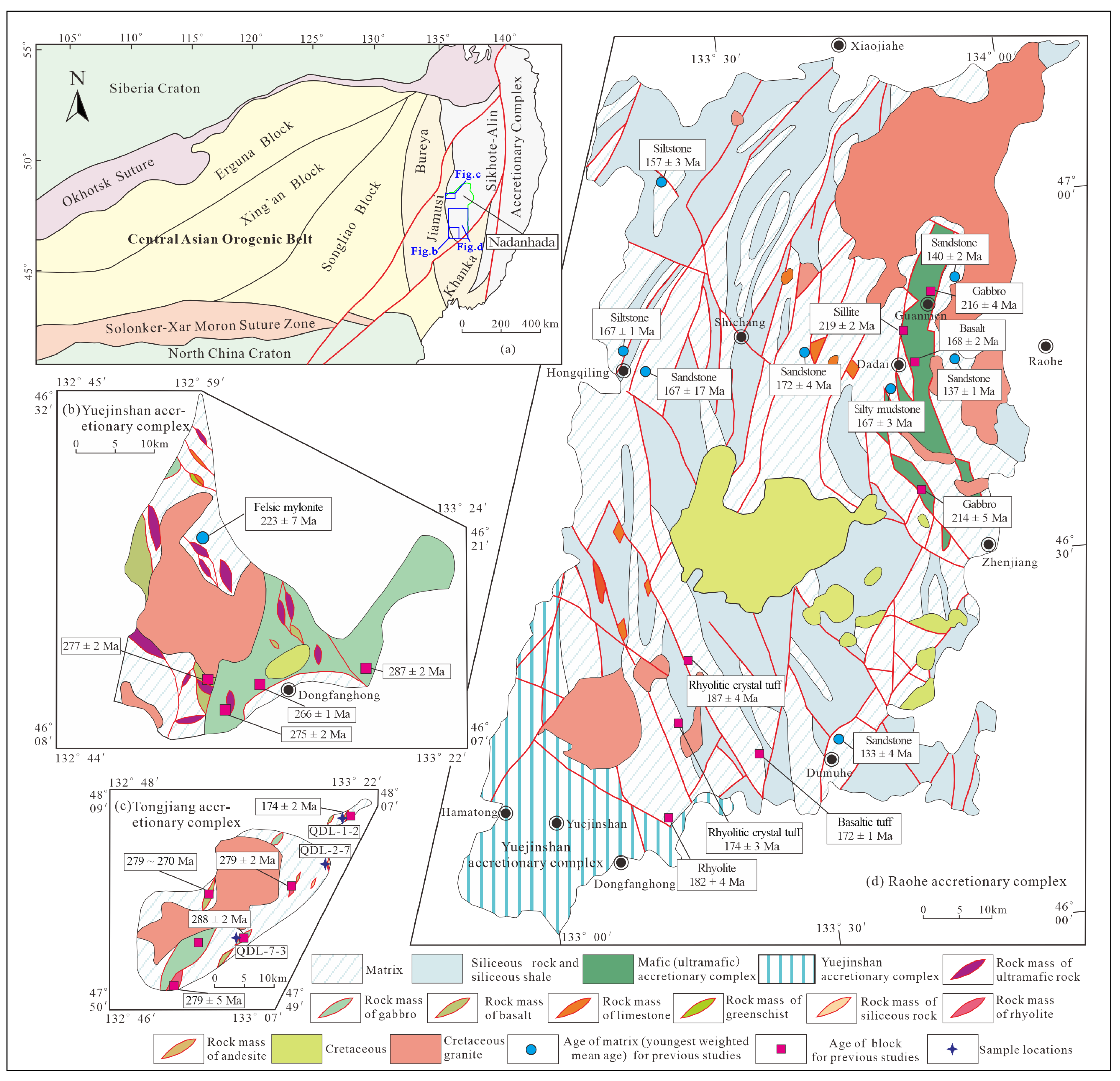



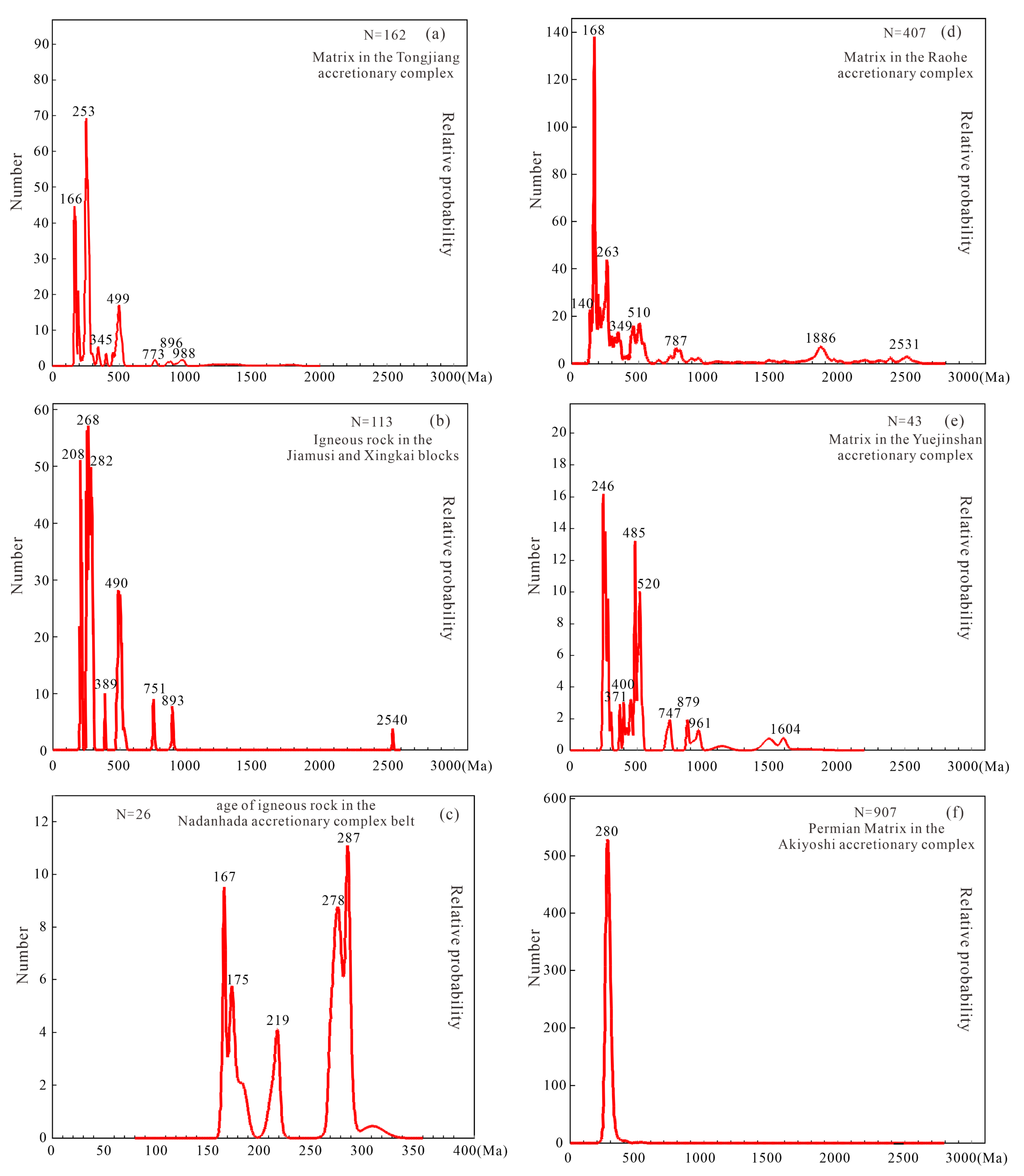
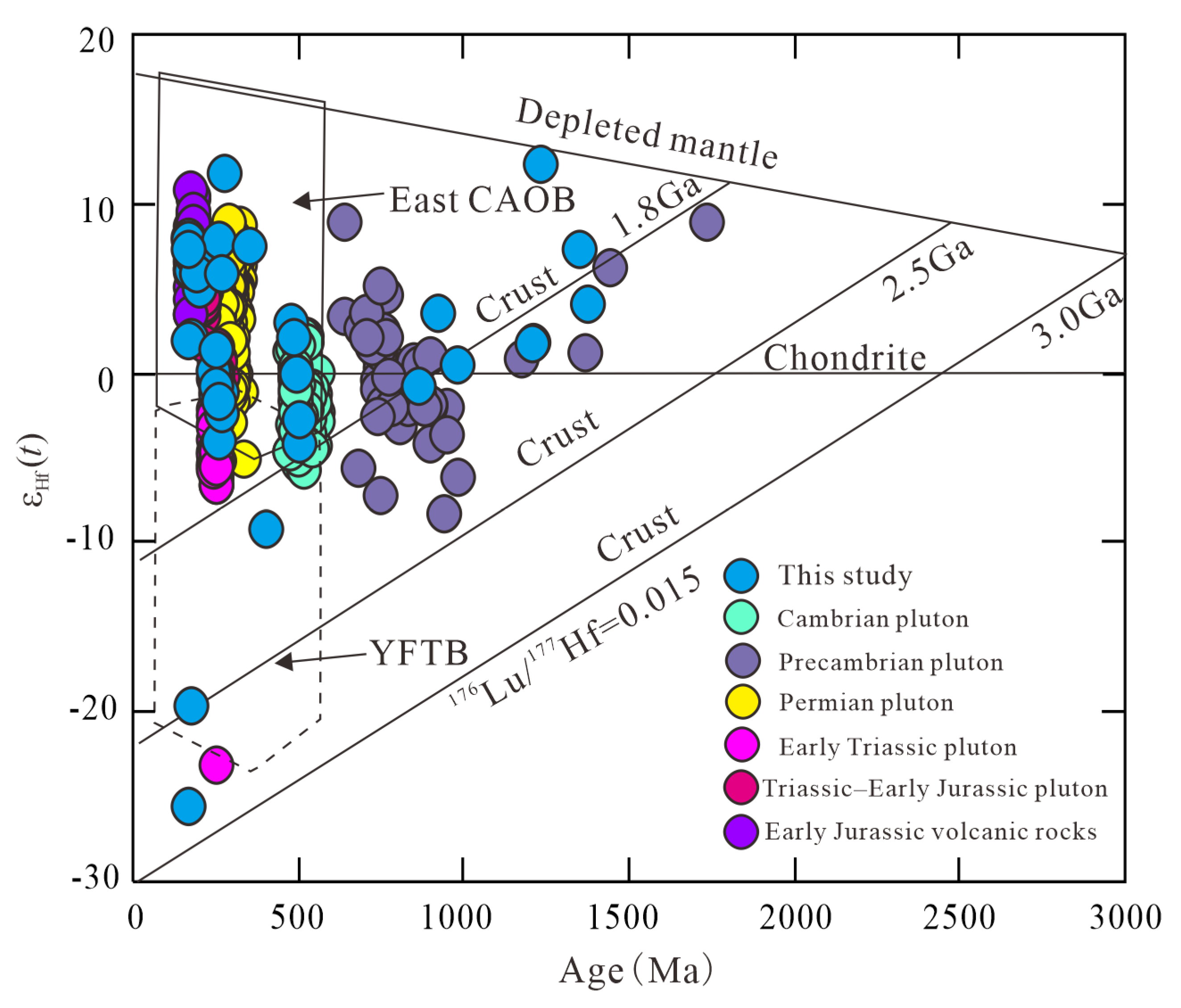
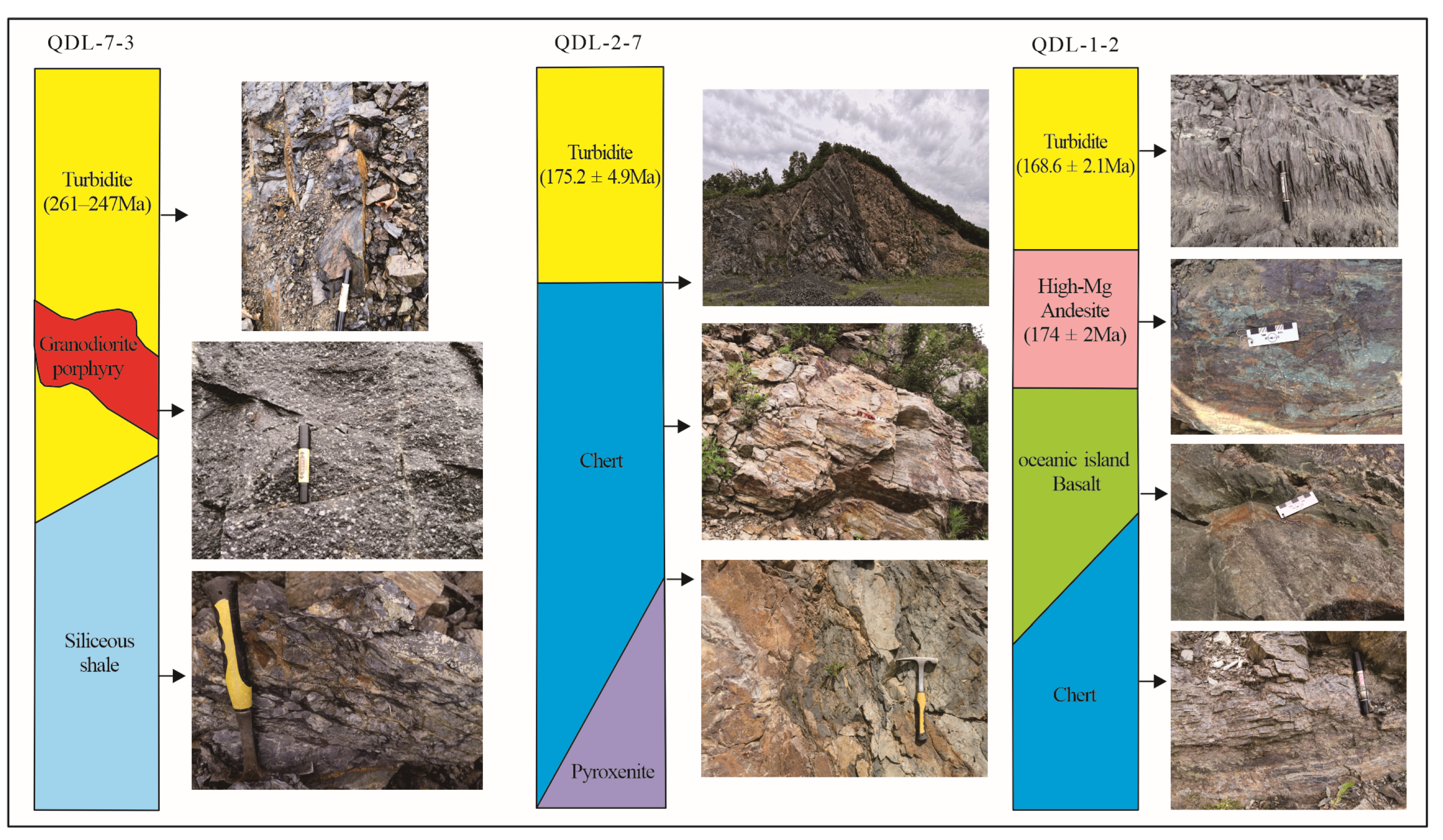
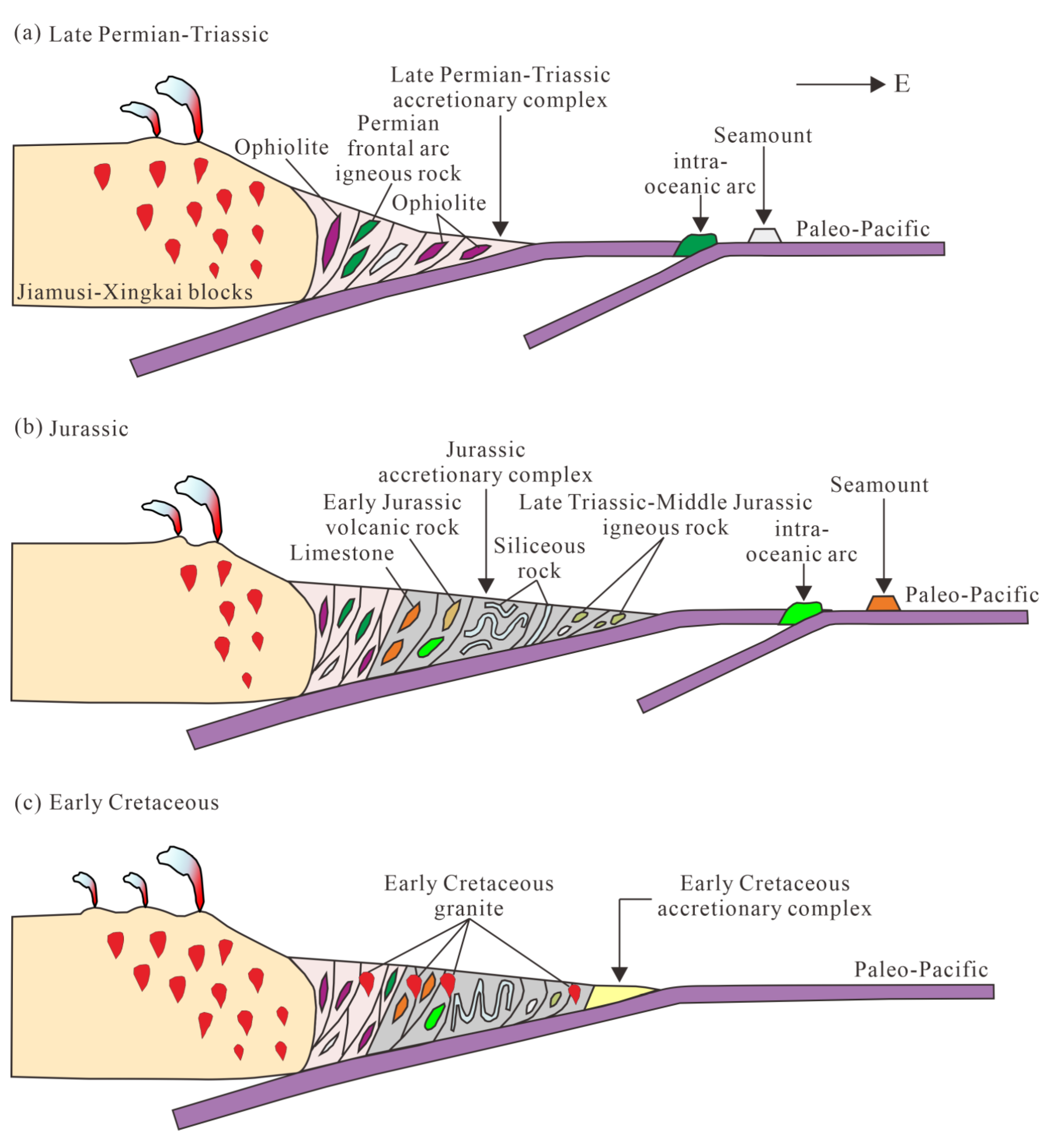
Disclaimer/Publisher’s Note: The statements, opinions and data contained in all publications are solely those of the individual author(s) and contributor(s) and not of MDPI and/or the editor(s). MDPI and/or the editor(s) disclaim responsibility for any injury to people or property resulting from any ideas, methods, instructions or products referred to in the content. |
© 2023 by the authors. Licensee MDPI, Basel, Switzerland. This article is an open access article distributed under the terms and conditions of the Creative Commons Attribution (CC BY) license (https://creativecommons.org/licenses/by/4.0/).
Share and Cite
Du, B.; Li, C.; Liu, F.; Liu, T.; Liu, Y.; Wang, X.; Liu, Y.; Zhang, T. Subduction–Accretion History of the Paleo-Pacific Plate Beneath the Eurasian Continent: Evidence from the Tongjiang Accretionary Complex, NE China. Minerals 2023, 13, 1038. https://doi.org/10.3390/min13081038
Du B, Li C, Liu F, Liu T, Liu Y, Wang X, Liu Y, Zhang T. Subduction–Accretion History of the Paleo-Pacific Plate Beneath the Eurasian Continent: Evidence from the Tongjiang Accretionary Complex, NE China. Minerals. 2023; 13(8):1038. https://doi.org/10.3390/min13081038
Chicago/Turabian StyleDu, Bingying, Chenglu Li, Fei Liu, Tianjia Liu, Yuwei Liu, Xunlian Wang, Yong Liu, and Tiean Zhang. 2023. "Subduction–Accretion History of the Paleo-Pacific Plate Beneath the Eurasian Continent: Evidence from the Tongjiang Accretionary Complex, NE China" Minerals 13, no. 8: 1038. https://doi.org/10.3390/min13081038
APA StyleDu, B., Li, C., Liu, F., Liu, T., Liu, Y., Wang, X., Liu, Y., & Zhang, T. (2023). Subduction–Accretion History of the Paleo-Pacific Plate Beneath the Eurasian Continent: Evidence from the Tongjiang Accretionary Complex, NE China. Minerals, 13(8), 1038. https://doi.org/10.3390/min13081038





